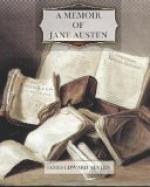Some persons have surmised that she took her characters from individuals with whom she had been acquainted. They were so life-like that it was assumed that they must once have lived, and have been transferred bodily, as it were, into her pages. But surely such a supposition betrays an ignorance of the high prerogative of genius to create out of its own resources imaginary characters, who shall be true to nature and consistent in themselves. Perhaps, however, the distinction between keeping true to nature and servilely copying any one specimen of it is not always clearly apprehended. It is indeed true, both of the writer and of the painter, that he can use only such lineaments as exist, and as he has observed to exist, in living objects; otherwise he would produce monsters instead of human beings; but in both it is the office of high art to mould these features into new combinations, and to place them in the attitudes, and impart to them the expressions which may suit the purposes of the artist; so that they are nature, but not exactly the same nature which had come before his eyes; just as honey can be obtained only from the natural flowers which the bee has sucked; yet it is not a reproduction of the odour or flavour of any particular flower, but becomes something different when it has gone through the process of transformation which that little insect is able to effect. Hence, in the case of painters, arises the superiority of original compositions over portrait painting. Reynolds was exercising a higher faculty when he designed Comedy and Tragedy contending for Garrick, than when he merely took a likeness of that actor. The same difference exists in writings between the original conceptions of Shakspeare and some other creative geniuses, and such full-length likenesses of individual persons, ’The Talking Gentleman’ for instance, as are admirably drawn by Miss Mitford. Jane Austen’s powers, whatever may be the degree in which she possessed them, were certainly of that higher order. She did not copy individuals, but she invested her own creations with individuality of character. A reviewer in the ‘Quarterly’ speaks of an acquaintance who, ever since the publication of ‘Pride and Prejudice,’ had been called by his friends Mr. Bennet, but the author did not know him. Her own relations never recognised any individual in her characters; and I can call to mind several of her acquaintance whose peculiarities were very tempting and easy to be caricatured of whom there are no traces in her pages. She herself, when questioned on the subject by a friend, expressed a dread of what she called such an ‘invasion of social proprieties.’ She said that she thought it quite fair to note peculiarities and weaknesses, but that it was her desire to create, not to reproduce; ‘besides,’ she added, ’I am too proud of my gentlemen to admit that they were only Mr. A. or Colonel B.’ She did not, however, suppose that her imaginary characters were of a higher order than are to be found in nature; for she said, when speaking of two of her great favourites, Edmund Bertram and Mr. Knightley: ’They are very far from being what I know English gentlemen often are.’




